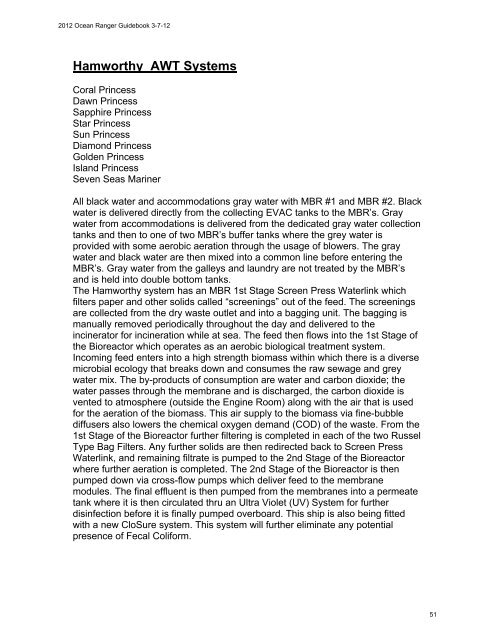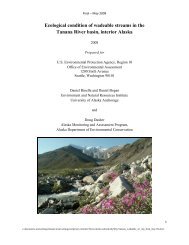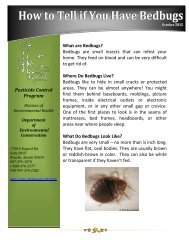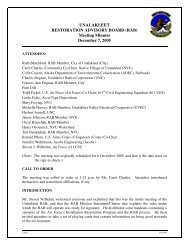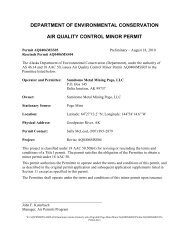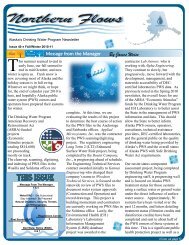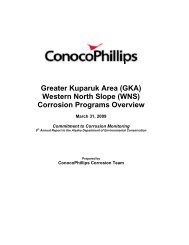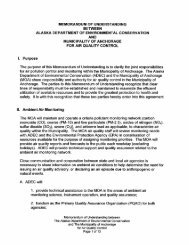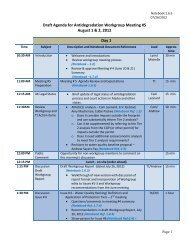2012 Ocean Ranger Guidebook Revision 3-7-12 - Alaska ...
2012 Ocean Ranger Guidebook Revision 3-7-12 - Alaska ...
2012 Ocean Ranger Guidebook Revision 3-7-12 - Alaska ...
Create successful ePaper yourself
Turn your PDF publications into a flip-book with our unique Google optimized e-Paper software.
<strong>20<strong>12</strong></strong> <strong>Ocean</strong> <strong>Ranger</strong> <strong>Guidebook</strong> 3-7-<strong>12</strong><br />
Hamworthy AWT Systems<br />
Coral Princess<br />
Dawn Princess<br />
Sapphire Princess<br />
Star Princess<br />
Sun Princess<br />
Diamond Princess<br />
Golden Princess<br />
Island Princess<br />
Seven Seas Mariner<br />
All black water and accommodations gray water with MBR #1 and MBR #2. Black<br />
water is delivered directly from the collecting EVAC tanks to the MBR’s. Gray<br />
water from accommodations is delivered from the dedicated gray water collection<br />
tanks and then to one of two MBR’s buffer tanks where the grey water is<br />
provided with some aerobic aeration through the usage of blowers. The gray<br />
water and black water are then mixed into a common line before entering the<br />
MBR’s. Gray water from the galleys and laundry are not treated by the MBR’s<br />
and is held into double bottom tanks.<br />
The Hamworthy system has an MBR 1st Stage Screen Press Waterlink which<br />
filters paper and other solids called “screenings” out of the feed. The screenings<br />
are collected from the dry waste outlet and into a bagging unit. The bagging is<br />
manually removed periodically throughout the day and delivered to the<br />
incinerator for incineration while at sea. The feed then flows into the 1st Stage of<br />
the Bioreactor which operates as an aerobic biological treatment system.<br />
Incoming feed enters into a high strength biomass within which there is a diverse<br />
microbial ecology that breaks down and consumes the raw sewage and grey<br />
water mix. The by-products of consumption are water and carbon dioxide; the<br />
water passes through the membrane and is discharged, the carbon dioxide is<br />
vented to atmosphere (outside the Engine Room) along with the air that is used<br />
for the aeration of the biomass. This air supply to the biomass via fine-bubble<br />
diffusers also lowers the chemical oxygen demand (COD) of the waste. From the<br />
1st Stage of the Bioreactor further filtering is completed in each of the two Russel<br />
Type Bag Filters. Any further solids are then redirected back to Screen Press<br />
Waterlink, and remaining filtrate is pumped to the 2nd Stage of the Bioreactor<br />
where further aeration is completed. The 2nd Stage of the Bioreactor is then<br />
pumped down via cross-flow pumps which deliver feed to the membrane<br />
modules. The final effluent is then pumped from the membranes into a permeate<br />
tank where it is then circulated thru an Ultra Violet (UV) System for further<br />
disinfection before it is finally pumped overboard. This ship is also being fitted<br />
with a new CloSure system. This system will further eliminate any potential<br />
presence of Fecal Coliform.<br />
51


